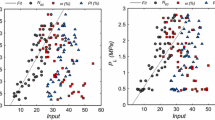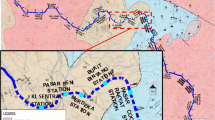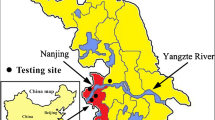Abstract
Pressuremeter is one of the most reliable geotechnical in situ tests to be utilized in estimating different soil properties. The main parameters that can be obtained from this test are soil deformation modulus. In general, the pressuremeter test is time-consuming and costly that requires suitable equipment and experienced operators. With these limitations, it is necessary to introduce models for indirect determination of the pressuremeter modulus (EPM). Based on the literature, various models and equations have been proposed to predict the modulus of pressuremeter; however, most of them are for fine-grained soils. In this paper, multiple linear regression (MLR), artificial neural network (ANN), and gene expression programming (GEP) have been used to design new relationships for prediction of the pressuremeter modulus. The main difference between this research and other studies is the use of 62 pre-bored pressuremeter tests results in cohesive and granular soils for training and testing models. The study area is in Tehran where soils show a variation from low plasticity clay to clayey gravel. The moisture content, depth of test, and grain size distribution of soils are considered as independent variables. Comparison of the predicted EPM with the actual modulus obtained from the pressuremeter tests indicates that the proposed relationships are able to estimate the pressuremeter modulus well. The results showed that the relationships obtained from nonlinear analyses performed by smart methods are more accurate and have less error in comparison to MLR method. Comparison of the coefficient of determination (R2) values and errors related to them in the testing phase show that the obtained results from the GEP method are more reliable than the ANN method. Also, sensitivity analysis revealed that the soil moisture content is the most effective parameter among the variables on the pressuremeter modulus.






Similar content being viewed by others
References
Mollahasani A, Alavi AH, Gandomi AH (2011) Empirical modeling of plate load test moduli via gene expression programming. Comput Geotech 38(2):281–286
Shahnazari H, Dehnavi Y, Alavi AH (2010) Numerical modeling of stress–strain behavior of sand under cyclic loading. Eng Geol 116(1–2):53–72
Murthy S (2008) Geotechnical engineering: principles and practice of soil mechanics, 2nd edn. CRC Press, Boca Raton
Menard L (1955) Pressiometre, Brevet Francais. de’invention. No 1.117.983
Menard L (1957) Mesure In situ des Proprietes Physiques Desols. Ann Ponts Chaussees 14:357–377
ASTM D4719 (2000) Standard test method for pre-bored pressuremeter testing in soils. ASTM International, vol 04-08
Keyabasi A (2012) Prediction of pressuremeter modulus and limit pressure of clayey soils by simple and non-linear multiple regression techniques: a case study from Mersin, Turkey. Environ Earth Sci 66:2171–2183
Adalag A, Kayabasi A, Gokceoglu C (2013) Estimation of pressuremeter modulus and limit pressure of clayey soils by various artificial neural network models. Neural Comput Appl 23:333–3339
Alavi AH, Gandomi AH, Chahkandi Nejad H (2013) Design equations for prediction of pressuremeter soil deformation moduli utilizing expression programming systems. Neural Comput Appl 23(6):1771–1776
Ziaie Moayed R, Kordnejad A, Mola Abasi H (2018) Pressuremeter modulus and limit pressure of clayey soils using GMDH type neural network and genetic algorithm. Geotech Geol Eng 36(1):165–178
Giakomino A, Abollino O, Malan Drino M, Mentasti E (2011) The role of chemometric in single and sequential extraction assays: a review part II, cluster analysis, multiple linear regression, mixture resolution, experimental design and other techniques. Anal Chim Acta 688:12–139
Akan R, Keskin SN, Unzundur Ukan S (2015) Multiple regression model for the prediction of unconfined compressive strength of jet grout columns. Procedia Earth Planet Sci 15:299–303
Yieldirim I, Ozashin S, Akyuz KC (2011) Prediction of the financial return of the paper sector with artificial neural networks. BioResources 6(4):4076–4091
Hannan SHA, Manza RR, Ramteke RJ (2010) Generalized regression neural network and radial basis function for heart disease diagnosis. Int J Comput Appl 7(13):7–13
Specht DF (1991) A general regression neural network. IEEE Trans Neural Networks 2(6):568–576
Ferreira C (2001) Gene expression programming: a new adaptive algorithm for solving problems. Complex Syst 13(2):87–129
Cevik A (2007) A new formulation for longitudinally stiffened webs subjected to patch loading. J Constr Steel Res 63(10):1328–1340
Kayadelen C (2011) Soil liquefaction modeling by genetic expression programming and neuro-fuzzy. Expert Syst Appl 38(4):4080–4087
Atici U (2016) Modeling of the elasticity modulus using gene expression programming. Adv Mater Sci Eng. https://doi.org/10.1155/2016/2063987
Author information
Authors and Affiliations
Corresponding author
Rights and permissions
About this article
Cite this article
Razavi, S., Goshtasbi, K., Noorzad, A. et al. Proposing new relationships to estimate the pressuremeter modulus of cohesive and cohesionless media. Innov. Infrastruct. Solut. 3, 67 (2018). https://doi.org/10.1007/s41062-018-0172-1
Received:
Accepted:
Published:
DOI: https://doi.org/10.1007/s41062-018-0172-1




